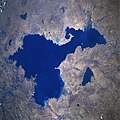Natron Lake
Soda or soda lakes are lakes with unusually high pH values and at the same time high salt contents.
The alkaline environment is mainly caused by sodium salts such as sodium carbonate and sodium hydrogen carbonate . The salts accumulate in lakes without drainage if the corresponding geological conditions are present (for example, rocks containing carbonate or volcanic activity) and high evaporation rates. Soda lakes are therefore mainly found in semi-deserts and steppes . The most famous soda lake is Lake Natron in Tanzania. But this type of water can also be found in North America, Asia and Southeast Europe.
Soda lakes are often rich in biomass. Due to the high pH values and salt concentrations, the organisms living here are alkaliphilic or alkali-tolerant and at the same time halophilic . The few specialized bacteria , archaea and algae can multiply en masse and in some cases lead to viewing depths of just a few centimeters. Some soda lakes are therefore among the most productive ecosystems in the world. Some of the unicellular organisms photosynthesize with the help of intensely colored pigments. It is these microorganisms, and not the dissolved salts, that are responsible for the unusual colors of numerous soda lakes. Specially adapted fish, the sodacichlids ( Alcolapia ), are found in three East African soda lakes .
Some soda lakes are used to produce natural soda .
Examples
Satellite image of the southern Lake Natron in Tanzania. In the enlarged section, bright salt crusts are visible in the shallow water.
Laguna de Urao, a lake of soda in the state of Mérida in Venezuela .
The Neusiedlersee is a European soda lake.
The Lake Van in Turkey.
The Lake Turkana in East Africa.
The Langano is also located in the East African Rift .
Lake Nakuru in Kenya.
The Mono Lake in California.






